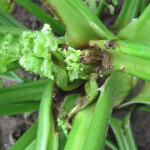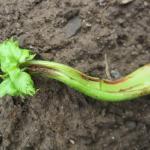Celery, Anthracnose
Once uncommon, anthracnose has become an important disease of celery in the past decade. It has been reported in most major celery growing areas worldwide, including Japan, Australia, and the USA.
Identification
Curled, distorted leaves and twisted petioles are characteristic of celery anthracnose—this symptom gave this disease it’s other name, celery leaf curl. These symptoms resemble those caused by exposure to 2,4-D herbicides. Plants may be stunted and chlorotic. Small, light brown, oval lesions on petioles turn dark reddish brown to black as the disease progresses. Lesions displaying gall tissue and adventitious roots are sometimes observed. Invasion by secondary bacteria may lead to heart rot, which can resemble black heart, a physiological disorder of celery caused by calcium deficiency.
Causal Agent
The fungus that causes celery anthracnose in the USA was first identified as Colletotrichum acutatum. It is now understood that it is not C. acutatum, but C. fioriniae and C. nyphaeae that are both capable of causing the disease. C. fioriniae also causes bitter rot in apples and has also been reported as the agent of anthracnose on scapes of elephant garlic. C. nymphaeae causes anthracnose of strawberries.
Life Cycle
Recent research indicates that the celery anthracnose pathogens are seedborne. Survival of C. fiorinae and C. nymphaeae in soil is currently not well understood, but it is likely that these species do survive in infected plant debris.
Infection and disease development is most common and severe in warm, wet conditions, when celery leaves remain wet for long periods of time. Spore germination and infection can occur when leaf wetness duration is <12 hours and temperatures are 59-76°F, but disease is most severe when the leaf wetness duration is >48 hours at temperatures of 77-86°F. In ideal conditions, symptoms may appear as little as 3-5 days after infection; however, infections may also remain asymptomatic for some time, until conditions become favorable for the pathogen.
Spores are spread primarily by splashing rain or irrigation water. The disease can continue to spread through the crop as long as environmental conditions are conducive to spore development and infection.
Several common weeds, including common lambsquarters, redroot pigweed, yellow nutsedge, oakleaf goosefoot, and common groundsel may also serve as hosts.
Cultural Management
- Sanitation is critical to management of celery anthracnose. Start with clean transplant trays. Scout greenhouses and fields regularly, especially during periods of high heat and humidity, and remove symptomatic plants. Inspect seedlings carefully prior to transplanting.
- Start with clean seed. Celery seed can be treated with hot water to kill pathogens on the surface and within the seed. Research in Japan has demonstrated that immersion of seeds in 50°C water for 30 minutes can eliminate the pathogen without significantly affecting germination rate. Click here for information about UMass Extension’s Hot Water Seed Treatment service.
- Field sanitation: Scout celery crops after periods of hot, humid weather, waiting until foliage is dry to enter field. Rogue out suspect plants and destroy. Remove any unharvested plants from the field as soon as harvest is complete and/or plow deeply to speed decomposition of crop debris in the soil.
- Minimize water splash to reduce spread. Avoid overhead irrigation if possible. Use mulch to minimize splashing of field soil onto plants.
- Control weeds to remove reservoir hosts and to improve air movement throughout your crop to encourage leaf drying.
- Avoid working with crops during wet weather and harvest as early in the season as possible.
- Crop rotation: Rotate away from celery for 3-4 years. The potential for C. nymphaeae to move between celery and strawberries is currently unclear, but in the interest of caution, rotation of celery with strawberries is best avoided.
- Resistant cultivars: No truly resistant cultivars are available; however, in trials conducted at the University of Michigan, the least susceptible of the cultivars tested were Merengo, Hadrian, Geronimo, and Balada.
Chemical Management
Many of the fungicides labeled for early blight (Cercospora) and late blight (Septoria) of celery may provide some protection against anthracnose. As of 2018, research was showing that strobilurin fungicides (FRAC Group 11) were most effective in preventing and controlling the disease. Group 11 fungicides should always be used in rotation with non-group 11 fungicides to deal with resistance build up. For up to date information on labeled fungicides, please see the New England Vegetable Management Guide.
The Center for Agriculture, Food and the Environment and UMass Extension are equal opportunity providers and employers, United States Department of Agriculture cooperating. Contact your local Extension office for information on disability accommodations. Contact the State Center Director’s Office if you have concerns related to discrimination, 413-545-4800 or see ag.umass.edu/civil-rights-information.



